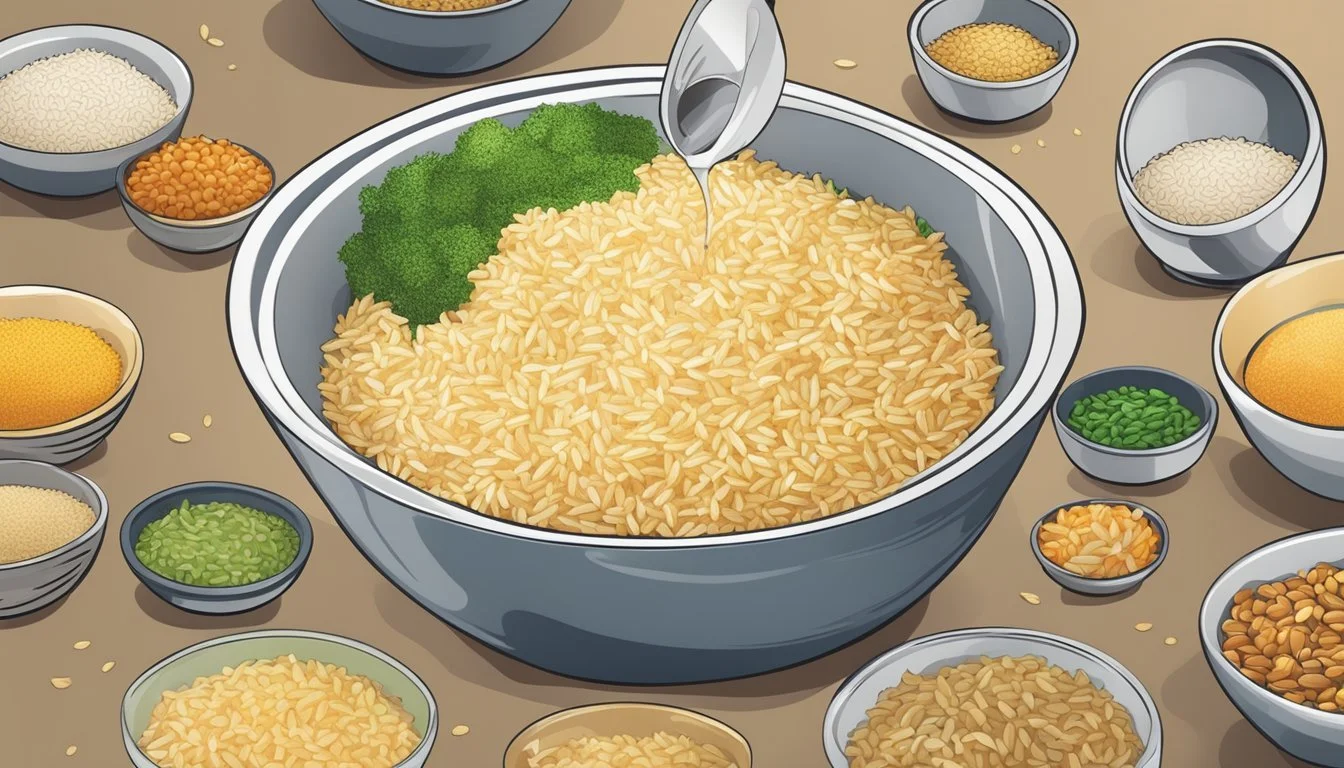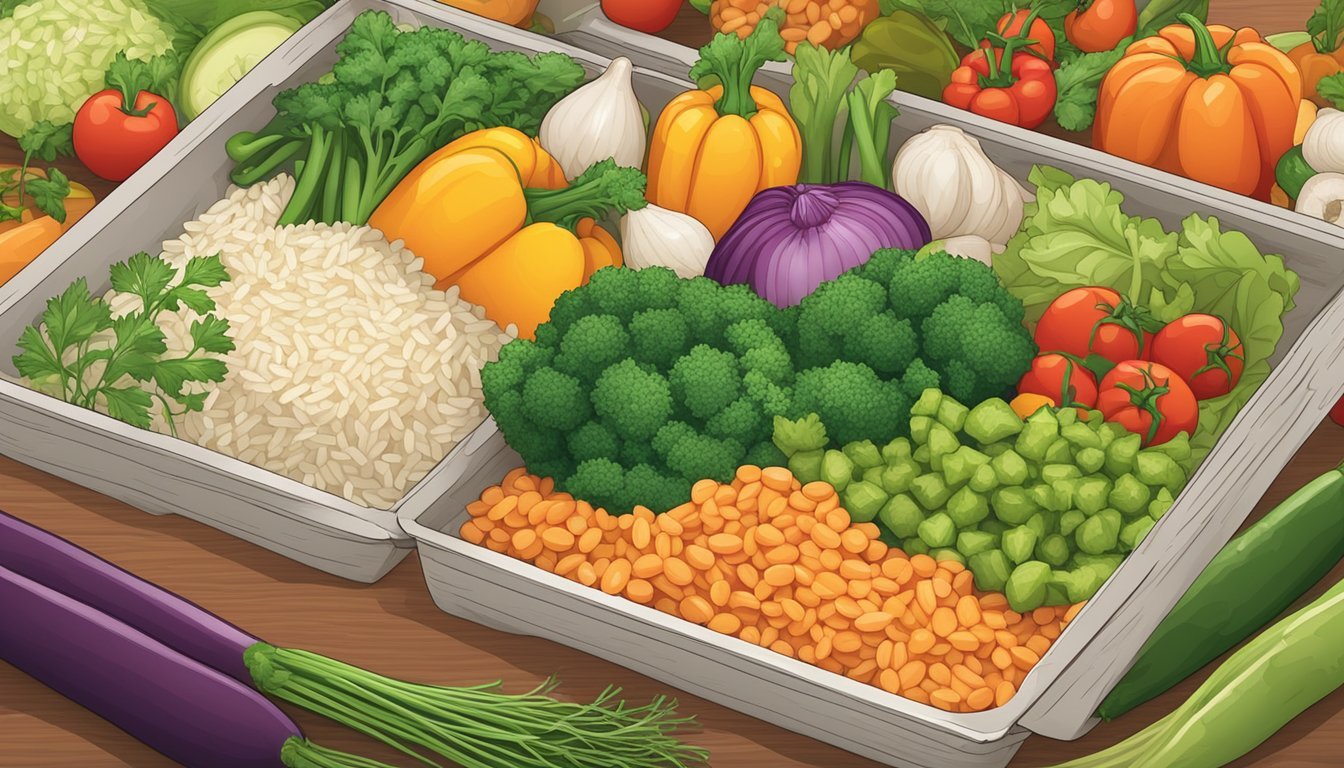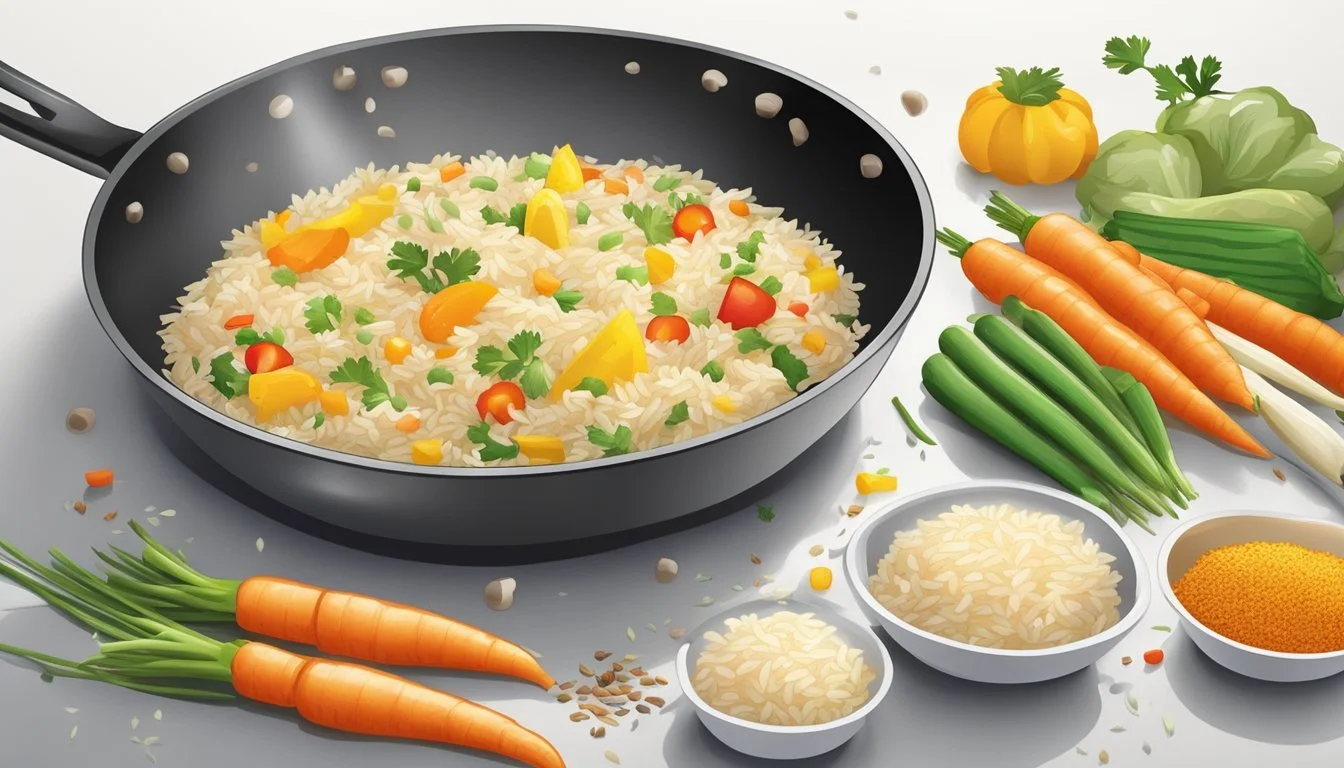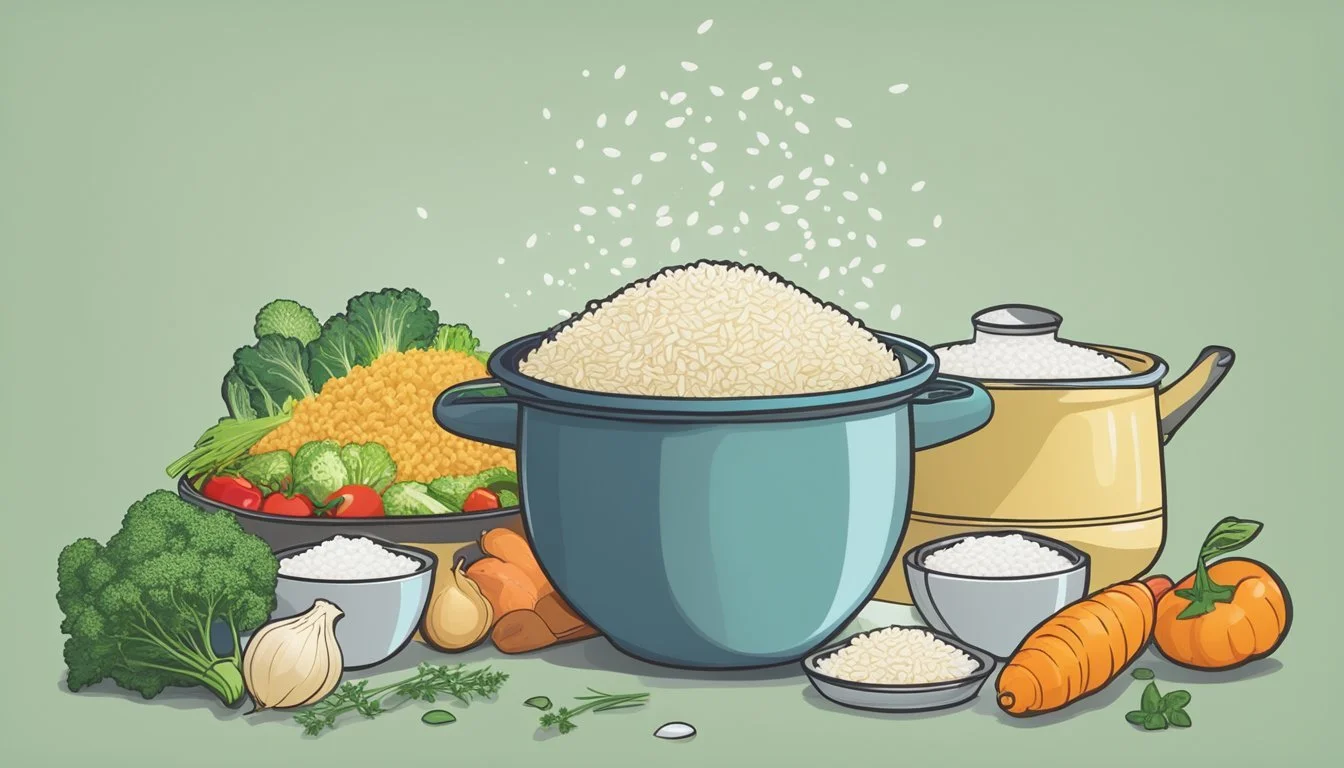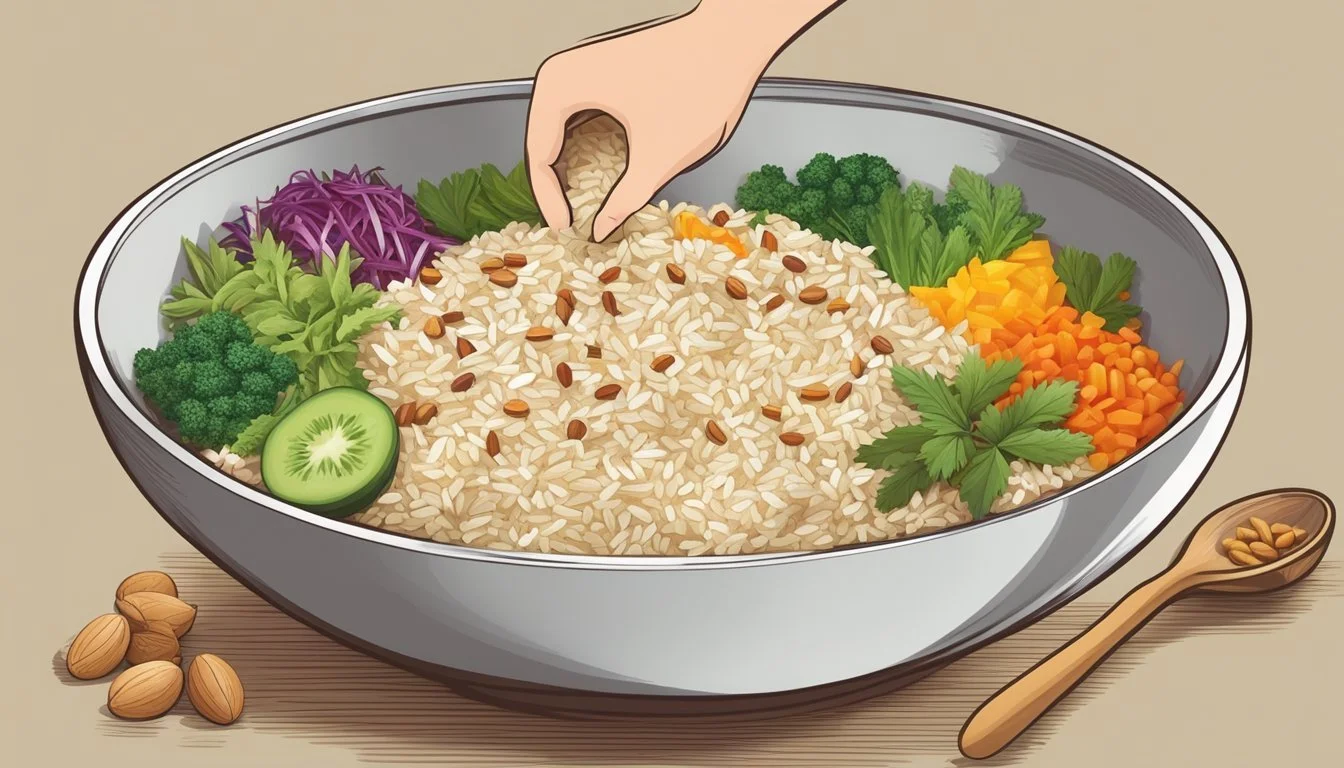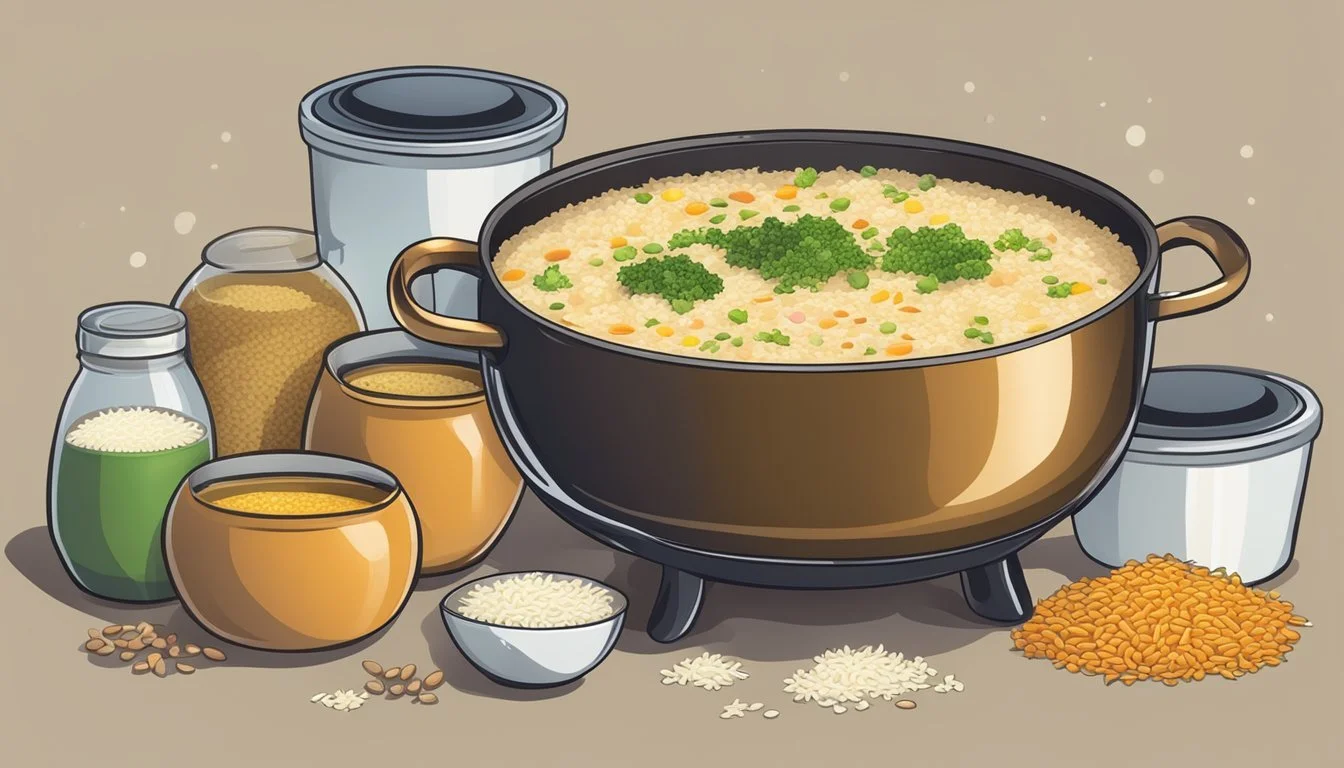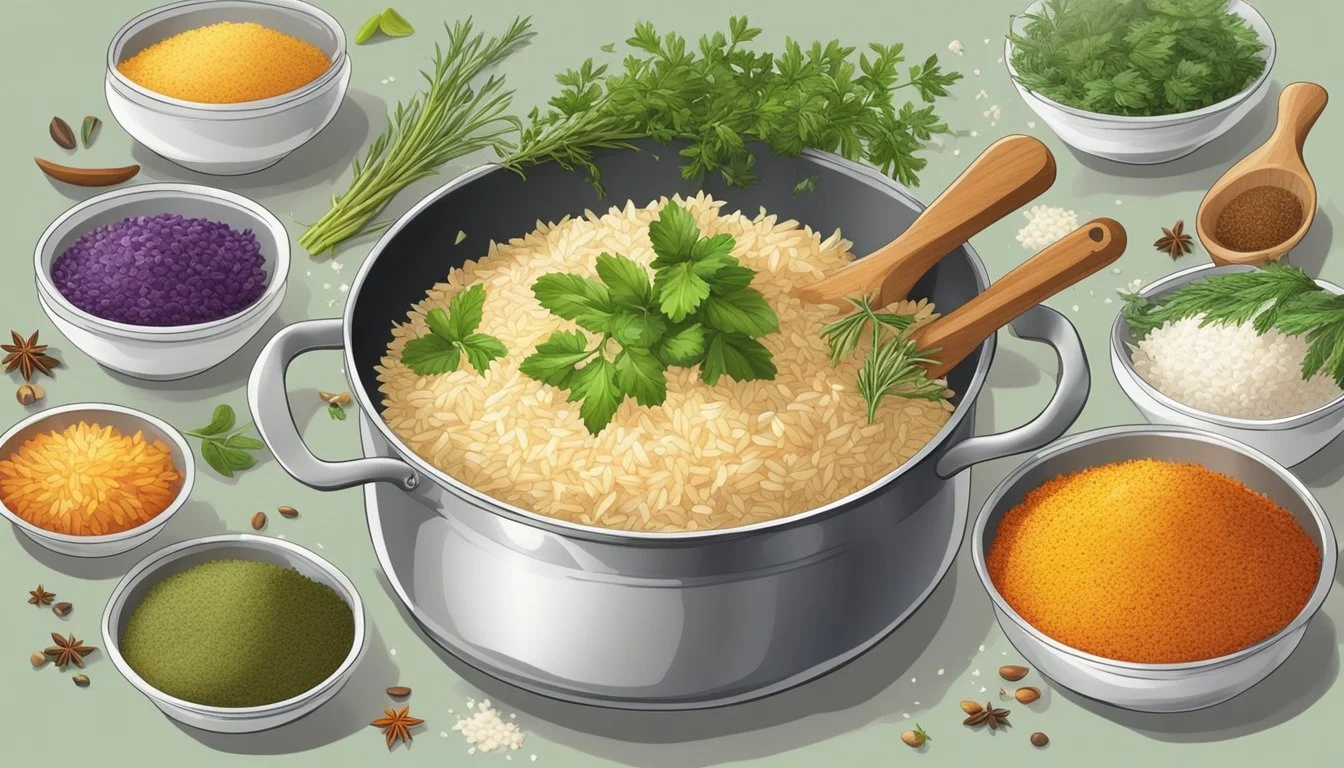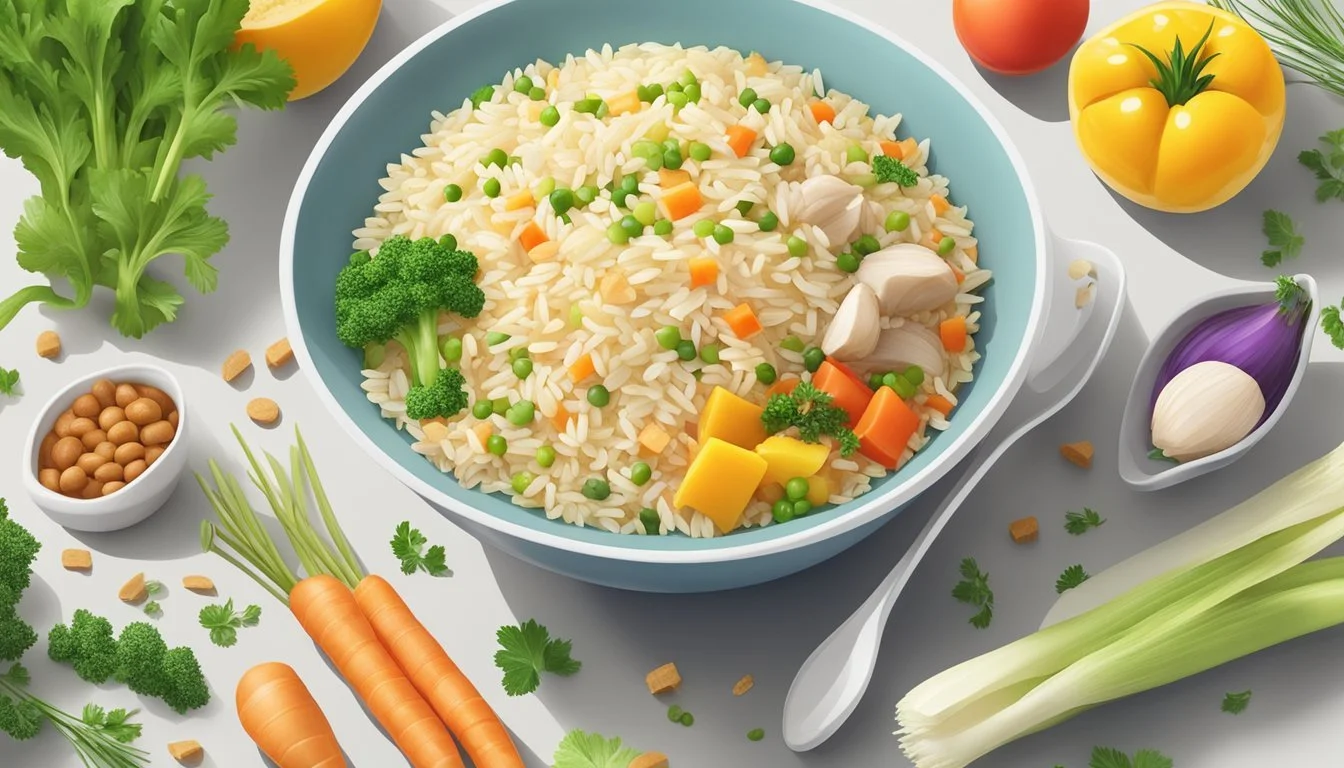Instant Rice Pilaf Mix-Ins
Elevate Your Meal in Seconds
Instant rice pilaf is a versatile dish that serves as a perfect backdrop for a variety of mix-ins. The basic combination of rice (What wine goes well with rice?), aromatics, and broth is an ideal canvas for a range of flavors and textures. For home cooks looking to elevate their rice pilaf, the integration of thoughtful mix-ins can transform this simple side into a standout component of any meal.
Incorporating ingredients such as vegetables, nuts, herbs, and proteins tailors the pilaf to complement specific dishes or to stand alone as a satisfying entrée. The key is to balance flavors and textures while ensuring the rice remains fluffy and distinct. Whether using an Instant Pot for efficiency or a traditional stovetop method, the process of creating a custom pilaf is straightforward and rewarding.
Experimentation with mix-ins leads to endless possibilities, allowing the pilaf to reflect seasonal ingredients, personal preferences, or culinary creativity. Fresh herbs bring brightness, toasted nuts offer crunch, and proteins such as chicken or beans can add substance, making the pilaf a more robust option. Understanding the foundation of rice pilaf preparation equips cooks with the ability to adapt the dish for any occasion.
What is Rice Pilaf?
Rice pilaf is a culinary dish that starts with rice and often incorporates a variety of flavor-enhancing ingredients. It typically involves sautéing rice in butter or oil before cooking it in broth, which imbues the dish with depth and richness.
Ingredients:
Rice: The base of the pilaf, often long-grain varieties like basmati or jasmine.
Broth: Chicken, vegetable, or beef broth is used to cook the rice, providing flavor.
Butter or Oil: Used for sautéing to add richness and aid in toasting the rice.
Instructions:
The rice is first sautéed in butter or oil to achieve a slight nuttiness in flavor.
Broth is then added, which the rice absorbs as it cooks, becoming tender and savory.
Additional ingredients, such as onions or garlic, can be sautéed along with the rice.
Rice pilaf is not just a side dish but a versatile foundation for endless variations. The combination of fluffy rice with the chosen broth and a light browning process elicits a distinct flavor profile that distinguishes it from plain boiled rice.
Why Rice Pilaf?
Flavor: The sautéing and simmering in broth deepen the taste.
Texture: Rice grains remain distinct and less sticky than plain rice.
Versatility: Serves as a complement to numerous main dishes and can be customized with various mix-ins.
In summary, rice pilaf is treasured for its enriched flavor and compatibility with a wide array of recipes, seamlessly fitting into diverse cuisines as a beloved staple.
Choosing the Right Type of Rice
When preparing Instant Pot rice pilaf, selecting the right type of rice is crucial for achieving the desired texture and flavor.
Basmati Rice: Known for its long grains and fragrant aroma, basmati rice is a superb choice for pilaf. It is available in white and brown varieties. White basmati rice cooks faster and provides a delicate texture, while brown basmati rice offers a nuttier flavor and more fiber but requires a longer cooking time.
Jasmine Rice: Another fragrant option is jasmine rice. Similar to basmati, jasmine rice has long grains but gives pilaf a slightly stickier consistency, making it ideal for those who prefer a clumpier texture.
For health-conscious individuals, brown rice serves as an excellent alternative. It retains the bran and germ, delivering more nutrients than its white counterpart. However, it does require more liquid and an extended cooking time, which should be adjusted in the Instant Pot settings.
Wild Rice Blend: Those aiming for a robust, earthy flavor can opt for a wild rice blend. It usually contains a mix of long-grain white rice, wild rice, and sometimes additional grains like quinoa. The diverse textures and flavors from the blend can elevate the pilaf to gourmet levels.
Here is a quick reference table for cooking times and liquid ratios:
Rice Type Liquid Ratio Approx. Cooking Time White Basmati Rice 1:1.5 4-8 minutes Brown Basmati Rice 1:1.25 22-28 minutes Jasmine Rice 1:1 3-5 minutes Brown Rice 1:1.25 22-28 minutes Wild Rice Blend 1:2 25-30 minutes
Always rinse your rice before cooking to remove excess starch and achieve a non-sticky texture. Adjust the liquid ratios and cooking times according to your Instant Pot model and personal preference.
Essential Ingredients for Flavor
When crafting an Instant Pot rice pilaf, certain ingredients are foundational for achieving a rich, savory flavor. These essentials include broth, onion, garlic, butter, olive oil, salt, and pepper, which work together to build a complex and satisfying taste profile.
Broth: A quality broth infuses the rice with depth and warmth. Chicken, vegetable, or beef broths are commonly used for their umami and savory notes.
Onion: A standard in many cuisines, onions contribute a sweet yet sharp dynamic when sautéed until softened.
Garlic: The unmistakable aroma of garlic adds a pungent kick, which becomes mellow and aromatic once sautéed with the onion.
Butter and Olive Oil: Both fats are used for sautéing aromatics, lending richness to the dish. Olive oil provides a fruity undertone, while butter offers a creamy back note.
Salt and Pepper: Fundamental seasoning agents, salt enhances natural flavors, while pepper introduces a mild heat.
Beyond these essentials, a mix of herbs and spices can elevate the pilaf significantly:
Herbs: Herbs like thyme or bay leaves are often added to complement the grains and aromatics with their earthy tones.
Spices: Incorporating spices such as a touch of cumin or paprika can layer additional flavor profiles into the pilaf.
Lastly, the inclusion of other aromatics like celery or carrots can round out the flavor spectrum, ensuring a rice pilaf that is both comforting and nuanced. Using these ingredients, the home cook can create a pilaf that is not only aromatic and flavorful but also visually appealing with a satisfying texture.
Instant Rice Pilaf Mix-Ins
When crafting a delightful bowl of instant rice pilaf, the versatility of mix-ins can turn the dish from simple to spectacular. Essentials such as garlic and onions provide a flavor base, while items like carrots, celery, and peas offer a colorful and nutritious boost. Those interested in enhancing the pilaf with a hint of sweetness might consider raisins or dried cranberries.
Protein can be seamlessly incorporated to make the dish more filling. Chicken, shrimp, (What wine goes well with shrimp?) or even flaky pieces of fish can be mixed in, ensuring the pilaf can serve as a complete meal. Vegetarians might opt for plant-based proteins or additional vegetables like broccoli, zucchini, or cauliflower.
Nuts and seeds introduce a satisfying crunch; choices such as slivered almonds, pecans, pistachios, or walnuts are not only healthy but also bring a rich texture. For those who appreciate a herbal note, fresh parsley, cilantro, or basil can be sprinkled on top before serving.
Cheese enthusiasts can sprinkle their pilaf with a cheese of their choice, adding a creamy dimension to the dish. To tailor the heat level, spices like cayenne or chili powder will provide a welcomed kick.
In summary, here is a quick guide to enhancing your instant rice pilaf with a variety of mix-ins:
Category Mix-Ins Veggies Carrots, Celery, Peas, Broccoli, Zucchini, Cauliflower Protein Chicken, Shrimp, Fish Nuts & Seeds Almonds, Pecans, Pistachios, Walnuts Sweet Add-Ins Raisins, Dried Cranberries Herbs Parsley, Cilantro, Basil Spices Cayenne, Chili Powder Cheese Your Preferred Choice
Remember to add these ingredients with confidence, knowing that each adds its own unique flavor and texture to your instant pilaf experience.
Cooking Methods
When cooking Instant Rice Pilaf, there are several key methods one should employ to ensure a tasty, fluffy outcome. Initiate the process by sautéing the base ingredients, which typically include onions and perhaps garlic, in the Instant Pot. This step imparts a deep flavor to the pilaf. Users should allow the onions to soften for 3-5 minutes, stirring occasionally.
After sautéing, it's important to briefly toast the rice with the sautéed base to unlock the grains' nutty flavor. The rice should change to a slightly more opaque color, a sign that it's well-coated with oil and ready for the next step.
Once the rice is toasted, liquid, such as broth or water, is added. At this point, users may introduce their choice of mix-ins for additional flavor. Pressure cooking comes next; the Instant Pot simplifies this step and takes less time than traditional stovetop methods.
Instant Pot Step Description Sealing the Lid Ensure it's properly sealed to allow pressure to build. Cooking Time Generally, white rice takes about 3-4 minutes, while brown rice requires closer to 22 minutes under high pressure. Natural Release After cooking, allow the pressure to release naturally for at least 10 minutes. This step is essential for retaining the rice's texture and keeping it fluffy.
Avoid quick releasing the pressure immediately after cooking, as this can create a less desirable texture and can cause sputtering of the starchy liquid. Patience during the natural release phase is key to perfect Instant Rice Pilaf.
Customizing Your Pilaf
Creating a delightful Instant Pot rice pilaf is a convenient way to bring a variety of flavors and textures to your table. By incorporating an array of ingredients, one can enhance the pilaf with both nutritional value and taste.
Vegetable Mix-ins: To boost the fiber content and add a colorful dimension to your pilaf, consider folding in some vegetables. Here's a suggested list of vegetables that marry well with pilaf:
Carrots (diced)
Peas (fresh or frozen)
Bell peppers (chopped)
Spinach (shredded)
Aromatic Infusions: Introduce a more complex and flavorful palate by including garlic or onions during the initial sauté phase. They impart a foundational flavor that carries through each bite.
Nutty Additions: For a nutty flavor and textural contrast, one can stir in some slivered almonds or pine nuts after the cooking process. This not only enhances the taste but also introduces healthy fats.
Lemony Zest: A bit of lemon juice or zest can brighten up the pilaf, offering a refreshing tanginess that cuts through the richness. It's best to add lemon at the end to retain its extra flavor.
Flavors Suggestions Citrus Fresh lemon juice or zest Herbs Parsley, thyme, or dill Spices Cumin, coriander, or a pinch of saffron Protein Chickpeas, cooked chicken, or shrimp
By following these additions, a standard rice pilaf can be transformed into a customized dish that reflects personal taste preferences and dietary needs, without compromising on style or substance.
Nutritional Benefits
Instant rice pilaf has the advantage of being a customizable dish that can cater to various nutritional needs. When considering mix-ins, one can significantly enhance the nutritional profile of the meal.
Calories: Instant rice pilaf as a base is relatively moderate in calories. Mix-ins such as vegetables or lean proteins can keep the meal balanced and prevent excessive calorie intake.
Fat: Typically, rice pilaf is low in fat. However, the addition of healthy fats through ingredients like olive oil or nuts contributes to heart health without substantially raising the fat content.
Sugar: Rice pilaf mix-ins usually don't add sugar, maintaining the dish's low sugar levels.
Fiber: Including vegetables like zucchini and cucumber increases the dish's fiber content, enhancing digestive health.
Potassium: Ingredients such as tomatoes or beans can boost the potassium level, which is crucial for heart and muscle function.
Vitamins: Vegetables also provide essential vitamins:
Vitamin A: Found in carrots, it's important for eye health.
Vitamin C: Tomatoes and peppers are rich in this antioxidant vitamin.
Calcium and iron: Adding greens like spinach to the pilaf will increase both calcium and iron, vital for bone health and energy levels respectively.
Gluten-free: Naturally, rice is gluten-free, making it a safe starch option for those with gluten sensitivities.
By carefully selecting mix-ins, one can create a rice pilaf dish that is not only flavorful but also rich in nutrients.
Serving and Pairing Suggestions
When considering side dishes to complement the delicate flavors of instant rice pilaf, a variety and balance of textures and tastes is key. One can serve rice pilaf as a versatile bed for proteins like grilled chicken or fish, which not only adds sustenance but also integrates well with the rice's subtle seasoning.
Fresh parsley sprinkled on top of rice pilaf not only adds a pop of color but also imparts a refreshing taste that contrasts nicely with the rich flavors. A dash of black pepper can elevate the overall dish with its subtle heat and earthy notes.
Here is a simple guide for perfect pairings:
Side Dish Description Best Paired With Grilled Chicken A lean protein that pairs well with herbs and spices in the pilaf. Fresh greens, simple vinaigrette. Fish A light choice that complements the rice without overpowering it. Lemon wedges, a drizzle of olive oil. Roasted Vegetables Caramelized edges bring sweetness and depth of flavor. Hummus or tzatziki for dipping.
One can also consider the rice pilaf as the main stage and add mix-ins to create a one-dish meal. Adding nuts such as almonds or pine nuts introduces a delicious buttery crunch. If a hint of sweetness is desired, golden raisins can serve as a delightful addition. Here’s a quick mix-in to imitate:
A combination of sautéed mushrooms or cooked shrimp can transform rice pilaf into a substantial main course.
Remember to adjust the seasoning of side dishes to complement the rice pilaf rather than compete with it, and consider the overall harmony of your meal when selecting pairings.
Storage and Reheating Tips
Storing Leftovers
Proper storage of Instant Rice Pilaf leftovers ensures they maintain quality and safety. One should refrigerate leftovers within two hours of cooking to prevent bacterial growth.
In the refrigerator: Store in airtight containers to retain moisture and prevent absorption of other odors or flavors. Pilaf remains good for up to 5 days.
In the freezer: For longer storage, one can freeze the pilaf in freezer-safe bags or containers. It will be safe for consumption for up to 2 months, although quality may diminish over time.
Reheating Tips
Reheating should be done carefully to preserve texture and flavor while ensuring the pilaf is heated through.
Microwave Reheating:
Place the pilaf in a microwave-safe dish.
Sprinkle water over the top to add moisture.
Cover with a microwave-safe lid or wrap to promote even heating.
Heat on high power for 1-2 minutes, stirring halfway through.
Stove Top Reheating:
Transfer pilaf to a skillet or saucepan.
Add a small amount of water or broth.
Cover and heat over low to medium heat, stirring occasionally, until thoroughly warm.
Instant Pot Reheating:
Set Instant Pot to 'Sauté' mode for warming or 'Steam' with a trivet to avoid drying out.
Lightly sprinkle the pilaf with water.
Place in an oven-proof dish if using the steam method.
Heat until warm throughout, typically 3-5 minutes.
When reheating, one must ensure the rice reaches an internal temperature of 165°F or 74°C for food safety. Reheat only the amount of pilaf one plans to consume, as repeated reheating can deteriorate quality.
Understanding Broths and Stocks
When preparing Instant Rice Pilaf, the choice of liquid can greatly influence the final flavor. Broths and stocks represent a foundational element in culinary practices, providing depth and complexity to dishes.
Broth is typically made by simmering meats, vegetables, and seasoning in water. The simmering process extracts flavors, resulting in a light and flavorful liquid. Broths are often seasoned and ready to use. Chicken broth imparts a gentle, savory background while vegetable broth offers a subtle, herbaceous note, ideal for vegetarian options. Beef broth, with its robust flavor profile, pairs well with heartier rice pilaf variations.
Type Characteristics Common Uses Vegetable Broth Light, herbaceous, low in fat and protein Vegetarian dishes (What wine goes well with vegetarian dishes?) Chicken Broth Versatile, mild in taste, middle-range in body Wide range of recipes Beef Broth Dense, strong flavor, higher in body Hearty dishes
Replacing water with broth can significantly boost the umami and nutritive content of the pilaf. However, one must consider the sodium content in broths, which varies greatly. Low-sodium options are available, allowing for better control over seasoning and final taste.
In absence of broths or stocks, water serves as a blank canvas; chefs may add their own blend of herbs and spices to achieve the desired flavor. Remember that the key to a flavorful pilaf lies not only in the main ingredients but also in the quality and choice of the liquid used to simmer the rice.
Enhancing Flavors with Herbs and Spices
To infuse instant rice pilaf with robust flavors, the judicious use of herbs and spices is key. They can effortlessly elevate the dish from plain to gourmet without significant effort or time.
Herbs: Fresh herbs add a burst of flavor. Parsley offers a fresh, slightly peppery taste, while basil contributes a sweet and savory profile. Cilantro provides citrus-like undertones, perfect for a more exotic twist. To integrate these herbs effectively, one should stir them into the pilaf just before serving, preserving their delicate essence.
Butter: A small pat of butter can enrich the pilaf, adding a creamy mouthfeel and a hint of richness. It's best added during the cooking process so it can melt and disperse evenly throughout.
Aromatics and Spices: Garlic and onions serve as foundational aromatics, imparting a savory depth when sautéed at the beginning of the cooking process. A pinch of salt enhances natural flavors, while black pepper adds a subtle heat. For those craving extra warmth, a touch of cayenne or chili powder can work wonders.
Acidic Notes: A squeeze of lemon juice introduced after cooking can brighten the dish, cutting through the richness and complementing the herbs.
Incorporating these elements requires balance — a heavy hand can overwhelm the rice. Starting with less and tasting often is recommended; one can always add more to suit personal preference. Here's a simple guide:
Ingredient Amount When to Add Butter 1 tbsp During cooking Garlic 1 tsp, minced Begin cooking Salt To taste During cooking Black Pepper 1/4 tsp After cooking Lemon Juice 1 tbsp After cooking Fresh Herbs 1/4 cup, chopped Before serving Cayenne 1/8 tsp (optional) During cooking
One should consider the balance of flavors and the desired final taste. The combination of these herbs, spices, and additional ingredients assures that the instant rice pilaf will be anything but ordinary.
The Role of Vegetables in Rice Pilaf
Vegetables play a crucial role in elevating the nutritional value and enhancing the flavor profile of rice pilaf. Incorporating a variety of vegetables can turn a simple rice dish into a vibrant and healthful meal.
Classic Additions:
Carrots: They add a sweet flavor and a pop of color.
Celery: Provides a subtle bitterness and crunchy texture.
Onions: Often sautéed until translucent, onions are essential for a savory base.
Nutritious Greens:
Peas: These are a sweet, bite-sized source of protein and fiber.
Broccoli: Rich in vitamins and adds a distinct texture when included.
Tender Offerings:
Zucchini: A quick-cook vegetable that offers a mild taste and softens well.
Cauliflower: When chopped finely, it can mimic the rice texture while adding nutrients.
For those who enjoy earthy flavors, (What wine goes well with earthy flavors?) mushrooms can be sautéed to release their moisture, enriching the pilaf with a deep, savory taste. It's important to cut these vegetables into uniform, bite-sized pieces for even cooking and a harmonious blend of textures and flavors.
Table of Suggested Vegetable Cooking Times in Pilaf:
Vegetable Prep Cook Time Notes Carrots Dice Medium Add with rice Celery Slice Medium Add early Onions Dice Until Translucent Sauté first Peas Whole Short Stir in last Broccoli Florets Short Steam on top Zucchini Dice Short Add near end Cauliflower Chop Medium Can mimic rice
The versatility of vegetables makes them perfect for instant rice pilaf mixes, offering consumers an array of options for customization. They not only contribute to the taste but also to the presentation and overall nutrition of the dish, making vegetables indispensable in rice pilaf.
Incorporating Proteins for a Complete Meal
In any hearty meal, protein is a key component that helps in satiety and nourishment. Instant rice pilaf can serve as a versatile base to which a variety of proteins can be added, creating a well-rounded dish. Here are popular options and tips on how to incorporate them:
Chicken: A classic choice, chicken can be either shredded or diced into bite-sized pieces. For quick meal prep, one can use rotisserie chicken or pre-cooked strips. They should be stirred in after the pilaf is fully cooked, allowing the residual heat to warm them through.
Fish: Delicate and flaky, fish like salmon or tilapia can be gently laid on top of the rice pilaf in the Instant Pot before cooking. The steam pressure will cook the fish to perfection.
Shrimp: This seafood option cooks quickly, making it a great last-minute mix-in. Shrimp should be added after the pilaf has finished cooking, and the pot has been set to 'sauté' for a few minutes. This method ensures they are adequately cooked without becoming rubbery.
Protein Preparation Cooking Method Chicken Shredded or Diced Stir in after cooking Fish Whole Piece Cook with rice pilaf Shrimp Whole or Chopped Sauté after pilaf is cooked
In each case, it is essential to ensure that the protein is cooked to the proper internal temperature as per food safety guidelines. One can also add seasonings aligned with the pilaf's flavor profile to enhance taste.
By mixing in a protein, instant rice pilaf can easily transform from a simple side to a complete meal, ideal for both individuals and families seeking a nutritious, quick dinner option.
Alternative Grains and Gluten-Free Options
When adapting a rice pilaf recipe to accommodate gluten-free diets or to simply diversify the grain selection, there are a wealth of options available. Quinoa, for instance, is a complete protein and an excellent gluten-free substitute that holds flavors well, making it a healthy and versatile choice for pilaf.
For those favoring a nuttier taste and chewier texture, brown rice and wild rice are excellent gluten-free alternatives. Brown rice, in particular, offers more nutrients than white rice because it retains the bran and germ. Wild rice, which is actually a grass, brings a distinct, earthy flavor and pairs beautifully with heartier mix-ins.
Basmati and Jasmine rice can also be used in pilaf recipes to bring a fragrant aroma to the dish. Though not gluten-free, their unique flavors can elevate a simple pilaf. Here's how they compare:
Rice Type Characteristics Gluten-Free Wild Rice Earthy flavor, chewy texture, grain-like appearance Yes Brown Rice Nutty flavor, firmer texture, higher nutritional value Yes Basmati Rice Aromatic, long-grain, becomes fluffy when cooked No Jasmine Rice Fragrant, slightly sticky, soft and slightly sweet No Wild Rice Blend Combination of rice types, varied flavors and textures Largely Yes
Individuals looking for a gluten-free pilaf should ensure that any added broth or flavorings are also free from gluten. By integrating alternative grains, one not only accommodates dietary restrictions but also introduces a delightful variety of flavors and textures to the traditional rice pilaf.


